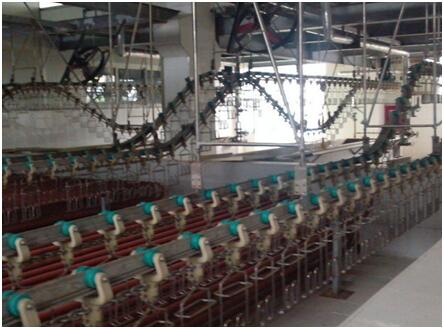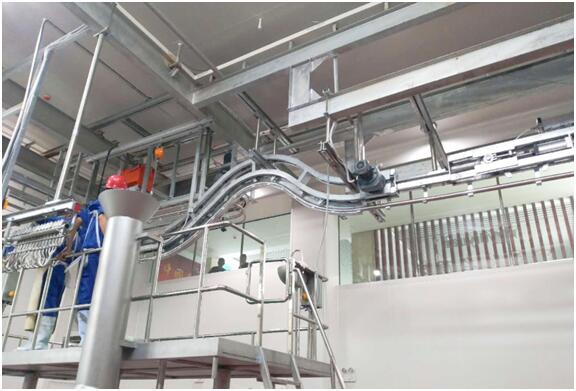Background
With the IoT box in the production line, we get real-time collection of the outputs of the poultry products, production line status, production situation, real-time summary uploading of the headquarters office system, real-time data collection management and monitoring. The main needs are as follows:

1. It can view the running data and status of the device anytime and anywhere, and can set important parameters remotely;
2. Receive equipment alarm information in time and monitor equipment historical data;
3. Remotely manage equipment, record and query equipment files and maintenance information;
4. Provide mobile phone APP and PC end software to the end users to remote device;
5. Access permissions, each enterprise can only see its own data;
6. V-Box positioning function, video monitoring;
Solution
By the V-box in the cabinet, we can get real-time data of the output of the poultry products, production line status, production status, real-time summary uploading of the headquarters office system.
1. The chicken, duck and goose slaughtering production line if fit for a variety of poultry, making full use of equipment resources for a variety of poultry slaughtering and processing, effectively avoiding the repeated increase of slaughtering equipment and saving money.
2. The slaughtering and processing equipment has stable performance, safe and convenient operation and long service life.
3. It adopts stainless steel T-shaped track. It can realize the whole process line processing for corona, slaughter, leachate, peeling, net smashing, claw cutting, cleaning, pre-cooling, segmentation and packaging.
4. Suitable for mass slaughter of chicken, duck and goose breeds. Suitable for: micro, small, medium and large poultry slaughtering and processing enterprises.
5. According to the customer's needs, we can design and customize the production line with different specifications and output. The production of poultry slaughter is: (100~7000), and the production line with different slaughter can be arbitrarily selected.
6. The price of the whole set of equipment is offered according to the material, model, specification, quantity, and output of the equipment required by the customer.

Working Processing
Hanging on poultry→Electric hemp→Leave blood→remove fur→Depilation→Dip wax→Cold wax→Pre-cooling →Drain → Split → Pack
2.1 hanging duck slaughter line
First, the duck must be removed from the carrier, and then gently lift the duck out of the cage. The ankle joints of both hands are held upside down on the duck.
2.2 Stun
Stunning is to pass the ducks to be slaughtered in various ways, which is conducive to the next slaughtering work. Currently, the most common method of stun is electrosurgical. This method is to use the current stimulation to stun the duck. The voltage used is usually 36-110 volts. We can set up an electric stun pool, the current at the bottom of the pool is passed, and the inside is filled with water. When the duck passes through here, it will faint when an electric shock occurs.
2.4 heat fur
After the blood is discharged from the duck, it is necessary to be scalded. First, duck must passes the pre-scalding pool. The water temperature of the pre-scalding pool is between 50-60 ° C, and after entering the immersion pool by strong spraying. The water temperature control of the scalding pool is critical and directly affects the hair removal effect of the duck. Generally, the temperature can be adjusted to about 62 ° C, and the entire scalding process takes 2-5 minutes.
2.5 remove fur
The large-scale slaughterhouses use mechanical de-feathering. The general hair removal rate of mechanical de-feathering can reach 80%-85%.
2.6 Three times of immersion
After removing the fur, big hair on the Flesh has been fallen off. However, there is still a small part of the hair remaining. In order to make it clean, we can use the edible wax to remove all the. Before that, we should first plug the nostrils of the duck with a small wooden stick to avoid waxing.
Adjust the temperature of the dipping wax tank to around 75 °C. When the duck passes through the immersion pool, the whole flesh will be covered with the liquid. After passing through the immersion pool, it will be cooled in time through the cooling tank. The cooling water temperature is below 25 °C. The complete wax shell is then manually stripped, which ultimately reduces the small hair of the duck body flesh. Each duck is subjected to three times of immersion, three times of cooling, and three times of stripping to achieve the final hair removal effect.
In this process, the temperature of the immersion tank should be stable. If the temperature is too high, the wax shell of the duck flesh surface will be too thin, the flesh is burnt. If the temperature is too low, the wax shell is too thick. In addition, in order not to waste raw materials, the peeled wax shell can be placed in the side of the melting tank to be melted and continue to be used. After the last cooling is completed, the wooden stick on the nostrils of the duck should be removed in time and then proceed to the next process.
2.7 Tongue removal
After the immersion process is finished, the duck tongue should be removed. Here we use needle-nosed pliers. Needle-nose pliers should be sterilized before use. Just hold the duck tongue with a needle-nose pliers and pull it out. The pulled duck tongue should be placed in a special container for storage.
2.8 Cleaning tiny hair
After three times of immersion, tiny hairs deep in the flesh is still not removed off. At this time, manual plucking is required. The tools used to pull tiny fur are mainly scorpions. This operation is generally carried out in a water tank. Because only in the water, the small hair on the duck body will stand up and see more clearly.
2.9 Hair inspection, meat duck slaughter line, meat duck slaughter line
The ducks are handed over to a full-time hairdresser for inspection after cleaning the tiny hair. If a small amount of hair has not been removed, the inspector will have to rework until the small hairs on the duck flesh are all removed.
2.10 Inside cleaning
This process use the disinfected knife to cut the duck plaque along the midline of the lower abdomen of the duck, and then pull out the internal organs such as duck intestines, duck plague, esophagus, heart and liver, oil, lungs and trachea. The viscera that has been removed is placed in a container for storage. The tool used should be sterilized every 30 minutes.
2.11 Remove paws
The knife for removing paws must be sterilized before use. Cut with a knife along the ankle joint of the duck leg, then place the cut duck claw into a container.
2.12 Cleaning
After the inside cleaning is finished, there will be some blood pollution on the flesh surface and inside the duck, so the ducks should be cleaned inside and outside. Was them with water, so that there is no visible dirt on the surface of the carcass. After washing, the chain enters the pre-cooling disinfection tank.
2.13 Pre-colling
Pre-cooling is the last step in the slaughter process. The water temperature in the pre-cooling tank should not exceed 4 °C, generally around 2 °C. During the pre-cooling process, sodium hypochlorite is added to the tank from time to time, and the effective sodium hypochlorite concentration of the pre-cooling tank is always maintained at 200-300 ppm. Through this step, the bacterial infection rate during the sputum can be minimized for a disinfection purpose.
2.14 carcass segmentation
The division of duck flesh is mainly based on the processing order of the division to divide the bones of the meat duck flesh, usually divided into duck head, duck neck, duck wings, duck feet, etc.; by-product processing is mainly for the heart, liver, sputum, the intestines and other by-products such as the intestines and claws and tongues are processed separately according to the processing requirements.
After the flesh is divided, it is weighed and packaged. The bag should be tested and sterilized before use. The packaged product should be frozen in the -35 ° C library in time, and the chilled product should be placed in the -8 ° C stock.
2.15 Pack & Cooling
The product can be shipped after being weighed, packaged, graded, refrigerated and preserved. The safety of duck food is a systematic project with many links and complicated control process. This requires the staff to have a serious and responsible working attitude and master the basic operational skills in order to produce safe duck meat.
Advantages
1. Support mainstream PLC, support a variety of Internet access methods;
2. PC, APP, Web page can achieve data monitoring and device management functions;
3. Support multi-user function, which can realize equipment management personnel, field service personnel, terminal customers and other people with different limits to access and monitor different devices;
4. The data is transmitted to the cloud data server, and the data can be stored locally. It has the characteristics of remote query and transmission resume to ensure the data integrity of the system.